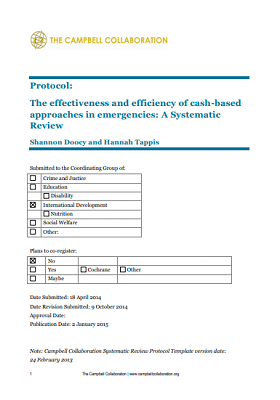The Effectiveness and Efficiency of Cash-Based Approaches in Emergencies: A Systematic Review
To access a document detailing the background, literature review, and objectives related to this review, please click here.
Cash-based approaches have been used for development purposes for a number of decades, particularly within social protection interventions in low- and middle-income countries. Over the past decade, cash transfer programs that were used in development contexts have increasingly been applied in humanitarian settings. Cash transfers aim to increase purchasing power and enable emergency-affected populations to meet their minimum needs for food and non-food items or to assist in livelihoods recovery. While commodity distribution is common in most humanitarian responses, it is sometimes inefficient and not always the most appropriate response. Cash-based approaches are able to address immediate needs more rapidly than commodity distribution because of reduced logistical complexity and they can stimulate local economies and markets by creating demand. Furthermore, cash transfers provide support in a way that maintains dignity and choice among emergency-affected populations.
Cash transfers have most commonly been used to address food insecurity and nutrition in emergencies. Humanitarian actors have transitioned from ‘food aid’ to ‘food assistance’ which refers to a broader set of approaches than food aid alone, and is inclusive of cash based approaches. Spending on cash programming in emergencies has steadily increased since the 2004 Indian Ocean tsunami as part of a gradual shift away from in-kind food as the default response towards a broader food assistance approach. Cash transfers have also been used to enable emergency-affected populations to pay rent, rebuild or repair shelters and damaged public infrastructure and to support livelihoods recovery; vouchers have been used as a mechanism to improve access to food, water, hygiene supplies, productive assets and inputs, and other non-food items in a range of settings. There is growing recognition that where markets are functioning, cash transfer mechanisms are an appropriate and effective alternative to support populations affected by emergencies. A wide variety of actors now fund or implement cash-based interventions in humanitarian emergencies, including governments, non-government organizations (NGOs) and civil society groups, and UN agencies including the World Food Program (WFP) and the UN Refugee Agency (UNCHR).
Despite the widespread adoption of cash transfer programs, there are few rigorous evaluations in the peer-reviewed literature on the effectiveness or efficiency of these interventions in sudden onset or protracted emergencies. The vast majority of peer-reviewed evidence is case-studies of specific programs, discussion pieces, or economic analyses of the cost-effectiveness of cash-based approaches over in-kind food assistance. There is growing recognition in grey literature that cash-based approaches are a valuable tool for humanitarian response in a wide range of contexts, however, the single most important message emerging from donor and implementing agency documentation is that cash-based approaches are highly context and event specific. There is a lack of evidence on which delivery mechanisms are most effective in different emergency contexts and with respect to achievement of different sector-specific objectives. This will review will synthesize the existing evidence on cash-based approaches in emergencies with the aim of informing donor policy and best practices.



